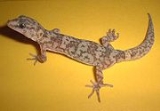
Phyllodactylus angustidigitus
Encyclopedia
The Paracas Gecko is a medium-sized gecko
with a maximum snout-vent length of 57 mm.
This species is endemic from the Ica Region
in southern Peru
, and its known geographical distribution is restricted to the Paracas National Reservation
, including two islands (La Vieja in the Bahia Independencia and Sangayan west of the Paracas Peninsula). This gecko most closely resembles Phyllodactylus gerrhopygus (a species that also occurs in southern Peru), from which it can be distinguished by smaller and more numerous terminal lamellae on the fourth toe.
Phyllodactylus angustidigitus inhabits sand dunes, rocky outcrops, and small hills throughout the desert in Paracas, though it is usually more abundant near shore. These geckos abound along shelly and gravel beaches, and seem to avoid sandy beaches. This gecko feeds on small invertebrate
s, including insect
s, crustacean
s and spider
s. Females appear to lay only one egg
.
Gecko
Geckos are lizards belonging to the infraorder Gekkota, found in warm climates throughout the world. They range from 1.6 cm to 60 cm....
with a maximum snout-vent length of 57 mm.
This species is endemic from the Ica Region
Ica Region
Ica is a region in Peru. It borders the Pacific Ocean on the west; the Lima Region on the north; the Huancavelica and Ayacucho regions on the east; and the Arequipa Region on the south. Its capital is the city of Ica.- Geography :...
in southern Peru
Peru
Peru , officially the Republic of Peru , is a country in western South America. It is bordered on the north by Ecuador and Colombia, on the east by Brazil, on the southeast by Bolivia, on the south by Chile, and on the west by the Pacific Ocean....
, and its known geographical distribution is restricted to the Paracas National Reservation
Paracas National Reservation
The Paracas National Reserve is located in Ica, Peru and consists of the Paracas Peninsula, coastal areas and tropical desert extending to the south slightly past Punta Caimán, a total of 335,000 ha . It includes Bahía de la Independencia and miles of coastal waters...
, including two islands (La Vieja in the Bahia Independencia and Sangayan west of the Paracas Peninsula). This gecko most closely resembles Phyllodactylus gerrhopygus (a species that also occurs in southern Peru), from which it can be distinguished by smaller and more numerous terminal lamellae on the fourth toe.
Phyllodactylus angustidigitus inhabits sand dunes, rocky outcrops, and small hills throughout the desert in Paracas, though it is usually more abundant near shore. These geckos abound along shelly and gravel beaches, and seem to avoid sandy beaches. This gecko feeds on small invertebrate
Invertebrate
An invertebrate is an animal without a backbone. The group includes 97% of all animal species – all animals except those in the chordate subphylum Vertebrata .Invertebrates form a paraphyletic group...
s, including insect
Insect
Insects are a class of living creatures within the arthropods that have a chitinous exoskeleton, a three-part body , three pairs of jointed legs, compound eyes, and two antennae...
s, crustacean
Crustacean
Crustaceans form a very large group of arthropods, usually treated as a subphylum, which includes such familiar animals as crabs, lobsters, crayfish, shrimp, krill and barnacles. The 50,000 described species range in size from Stygotantulus stocki at , to the Japanese spider crab with a leg span...
s and spider
Spider
Spiders are air-breathing arthropods that have eight legs, and chelicerae with fangs that inject venom. They are the largest order of arachnids and rank seventh in total species diversity among all other groups of organisms...
s. Females appear to lay only one egg
Egg (biology)
An egg is an organic vessel in which an embryo first begins to develop. In most birds, reptiles, insects, molluscs, fish, and monotremes, an egg is the zygote, resulting from fertilization of the ovum, which is expelled from the body and permitted to develop outside the body until the developing...
.

